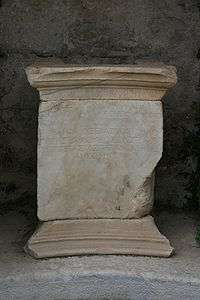Plinth

In architecture, a plinth (from French plinthe, from Latin plinthus, from Greek πλίνθος plinthos, “brick”) is the base or platform upon which a column, pedestal, statue, monument or structure rests.[1] Gottfried Semper's The Four Elements of Architecture (1851) posited that the plinth, the hearth, the roof, and the wall make up all of architectural theory. The plinth usually rests directly on the ground or stylobate. According to Semper, the plinth exists to negotiate between a structure and the ground. Semper's theory has been influential in the development of architecture.[2]
Many houses in flood-prone rural areas of Bangladesh are built on plinths ("homestead plinths").
The word is also used for the base of a cabinet or an audio turntable.
In dam engineering, the "plinth" is the link between the ground and the dam. For the case of arch dams, the term is changed to "pulvino".[3]
See also
References
- ↑ Poppeliers, John C. (1983). What Style is it?. New York, America: John Wiley & Sons. p. 104. ISBN 0-471-14434-7.
- ↑ Mallgrave, Harry Francis. Modern Architectural Theory: A Historical Survey, 1673–1968 (Cambridge, 2005). ISBN 0-521-79306-8
- ↑ P. Novak, A.I.B. Moffat, C. Nalluri, R. Narayanan Hydraulic Structures, Fourth Edition, CRC Press, 2007 ISBN 0-203-96463-2 p.168
| Look up plinth in Wiktionary, the free dictionary. |